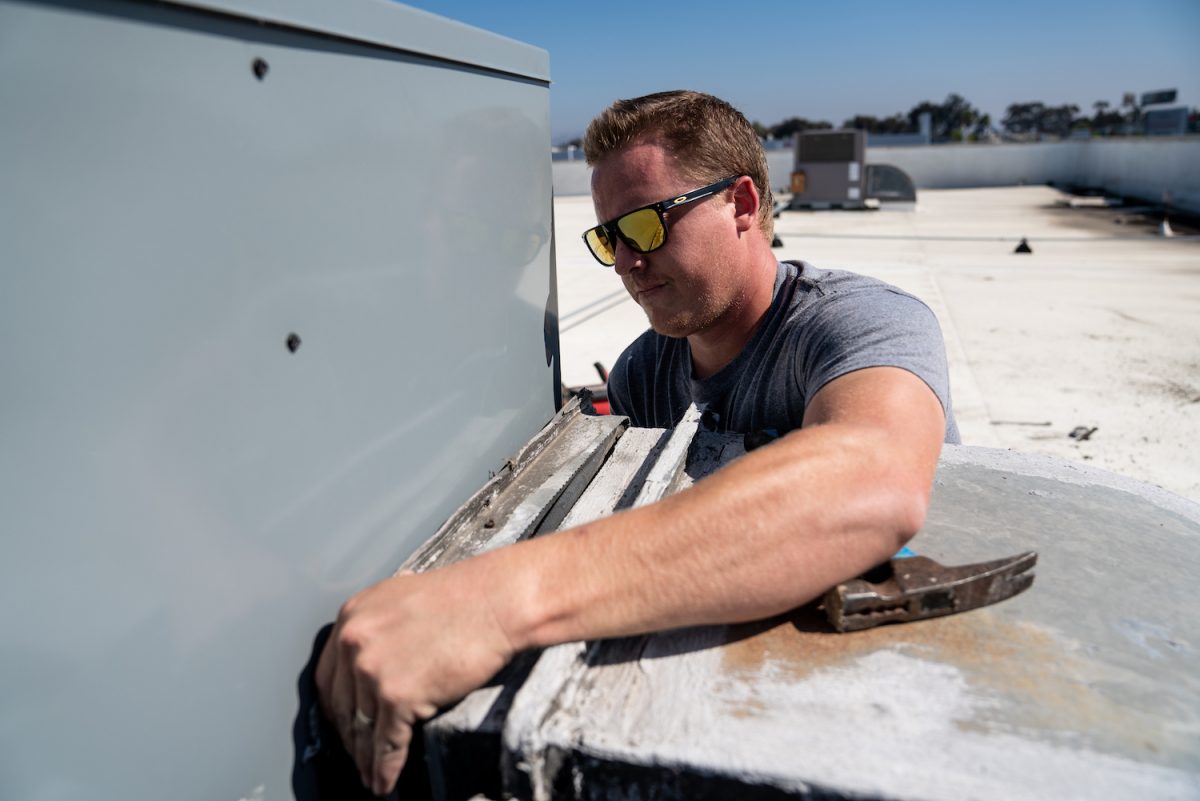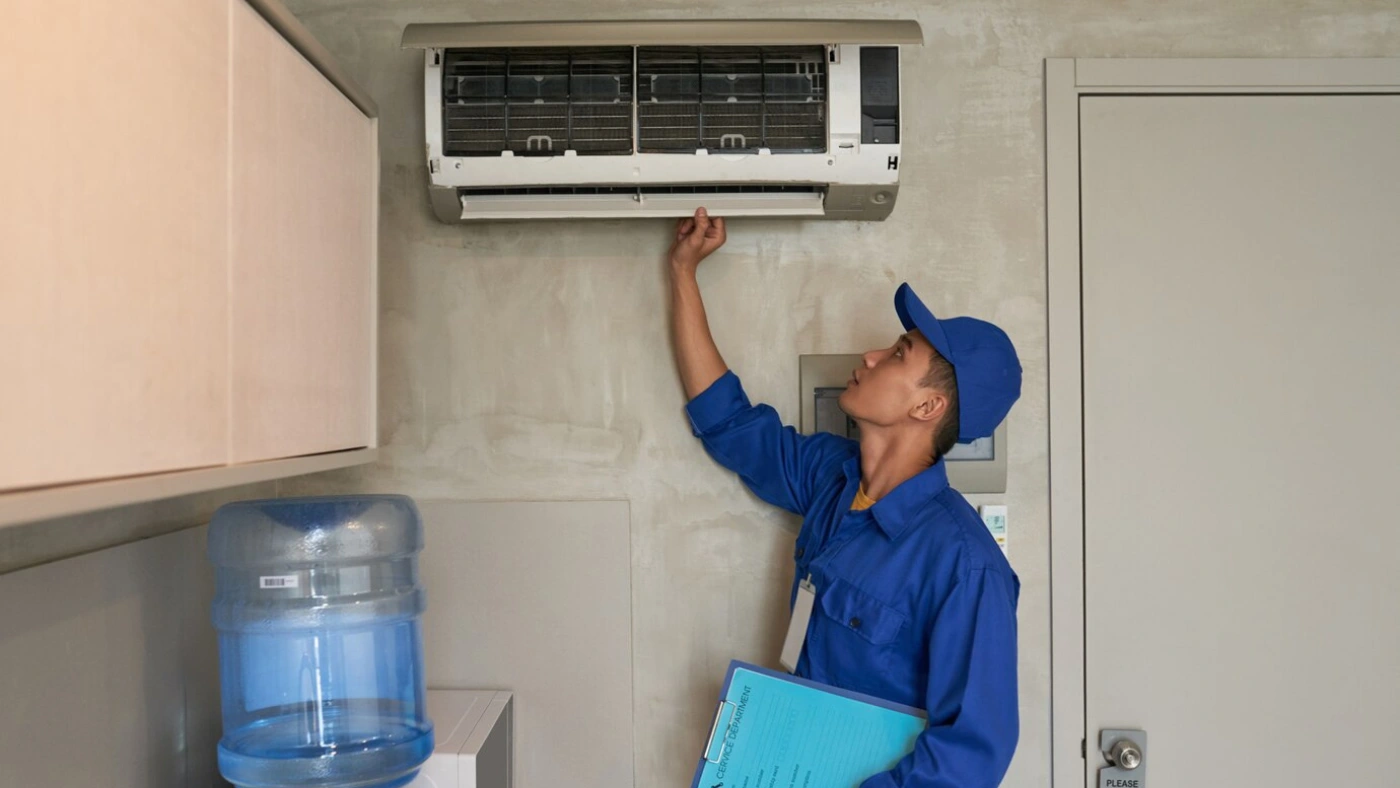
As a new HVAC technician, the first few months can be a bit overwhelming…
- Applying your new skills to real-world scenarios.
- Working to help customers resolve their heating and cooling issues for the first time.
- Making repairs in challenging environments—from attics to crawlspaces and in hot and cold weather.
In addition to your training, one of the critical aspects of making your acclimation to the job easier is having the proper set of tools. And as an HVAC technician, you’ll need plenty of them.
The below list will help take the guesswork out of what’s important on day one and what you can add over the course of your first few months on the job. Of course, depending on your circumstances, some of those “every so often” items could be necessary during your first few appointments.
This guide can serve as a handy checklist to ensure you keep yourself or your technicians well-outfitted for the next job.
Safety first
Before we get into the HVAC tools needed to get the job done, we must cover the items that will help keep you safe.
Yes, HVAC work isn’t high on the list of most dangerous professions, but there are plenty of risks and opportunities for injury. This handful of necessities will ensure your protection.
- Licensing – Not every state requires you to be a licensed HVAC professional, but many do. Get the lowdown from Housecall Pro’s licensing by state guides. Each contains the details you need to be a certified HVAC tech in your state.
- Goggles – Arguably the most critical item in your tool kit, goggles ensure debris and foreign material stay out of one the most vital organs in your body—your eyes. Make sure to test several pairs to guarantee a snug fit and clear vision.
- Gloves – Hand protection is always tricky as you’ll need gloves to protect your hands, but bulkier options sometimes make the job cumbersome. Try on plenty of different pairs to find the right combination of protection and workability.
- Ear protection – In the course of your career, you’ll have to use a power tool more than a few times, often in tight spaces and with the tool only arm’s length from your ears. Plugs or commercial-grade earmuffs will keep your hearing intact.
- Heavy duty work boots – Being on your feet all day, yet having the risk of heavy objects dropped on your feet, makes the right combination of lightweight yet protective, safety-toe footwear crucial.
- Hard hat – A hard hat may not be essential for everyday jobs, but it’s still a good idea to keep it handy. Low beams in attics can be painful, and calls to sites under construction are always a possibility.
- Heavy duty knee pads – There is no end to the squatting, bending, and kneeling that comes with being an HVAC technician. You should consider a pair of commercial-grade worker knee pads to limit wear and tear on your knees and protect from scrapes and cuts.
- Respirator – In general, you’ll rarely require the use of a respirator. If, however, you work on industrial units or handle an unusually high amount of dangerous chemicals on your jobs, a respirator is a must.
- Clothing – This may go without saying, but we’ll say it anyway. If you work for an HVAC business, they will likely provide an employee uniform. If not, workwear is perfect. Be sure to cover exposed skin.
The basics
No matter the job, no matter the location, these are the essentials you’ll use over and over. Ensure they are always part of your tool kit and regularly replace worn-out items.
- Templates – You’ll need to make sure your new HVAC business runs smoothly, so you’ll want templates specifically for HVAC operations to help get you going. From HVAC dispatcher scripts to resumes to estimates and HVAC rough-in checklists to get your business going quickly.
- Various screwdrivers – The one tool you’ll use above all others is a screwdriver. Access to any part of an HVAC system requires undoing some form of a screw. Make sure to have a variety of sizes in both Phillips, slotted, or flat head versions.
- Hammer – It may not immediately come to mind, but a hammer will be necessary almost daily. A standard fiberglass hammer is perfect for any job, and a small mallet is a nice extra to have, just in case.
- Pliers – Pulling, pinching, and cutting wires is an absolute must in practically every HVAC job. Make sure you have a variety of pliers, including needle nose, slip joint, diagonal, linesman, and groove joint.
- Wrench – You’ll face infinite nuts, bolts, and piping, so a variety of wrenches will simplify almost any task. A set of crescent and combination wrenches and a heavy-duty pipe wrench should be part of your toolset.
- Wire strippers – Stripping and reconnecting wiring is the norm for HVAC work. A heavy duty set of wire strippers will make the job far more manageable than a pocket or utility knife.
- Flashlight – Nobody wants to work in the dark. A standard flashlight will get the job done, but to be most effective, invest in a headlamp.
- Tape measure – You’ll need it far more often than you think, and when you do, it is beyond helpful—especially when measuring ductwork inside an attic. A retractable, 25-foot measuring tape is great for any job.
- Step ladder – You’ll find HVAC systems, ductwork, and vents in all kinds of locations. When you have to access those spots up high, a 4-foot step ladder will help you out.
- Drill – There will be a few times when new holes will be needed, or painfully tight screws need some extra power to undo. Early on, a cordless drill with various bits is more than enough for most issues. Later down the road, add a more powerful corded drill, which is good at handling tougher tasks.
- Extension cords – Ultimately, as your experience and tool kit grows, you’ll add specialty tools that can’t run purely on battery power. Make sure you always have an extension cord close by. An industrial-grade cord of any length between 50 and 100 feet will fit most any job site.
Tools of the trade
Throughout your daily schedule, many HVAC calls will end up being routine. But not all problems are solved with a screwdriver and a set of pliers. The complexity of HVAC systems means they require their own set of tools to make the right fixes.
The following list of gadgets and gear are your specialty items: the equipment that helps address even the most difficult of HVAC concerns.
- Multimeter – This can classify as a safety tool too, but a multimeter is an absolute requirement when working with electricity. And in HVAC, that means every single day. It checks for voltages around outlets, switches, and wires and is necessary for all technicians.
- Thermometer – This one might seem obvious, but an HVAC technician job is all about keeping the hot and cold. A handheld digital thermometer specific to measuring HVAC should be one of the first things you buy.
- Manifold gauge – Leaks are a fairly common problem with HVAC systems. To find them, a manifold gauge will be necessary. A digital version will be the easiest to read and useful when removing refrigerant or charging up a condenser unit.
- Vacuum pump – Excess moisture is a common issue with working with HVAC lines. To efficiently clear system lines, a vacuum pump is required.
- Psychrometer – A psychrometer is a must if you ever need to measure the mix and flow of air and determine relative humidity.
Extras to keep in the truck
Finally, these are the items that you won’t always need but will be glad your truck or van has them stocked up. These hyper-specific tools complete an HVAC technician’s toolbox, meaning no matter the scope of the job, you’ll have everything needed to finish it.
- Sawzall – You’d be surprised at what you’ll need to cut (or cut through) to accomplish your job as a tech. To make sure this doesn’t stop any repair, we commended a Sawzall, since it can cut through most simple materials, including drywall, sheet metal, pipes, and wood.
- Caulk gun – Once you finish working on a system, the final step is to close and seal everything up. A caulk gun makes the finishing touches easy to apply.
- Awl – There will be times when poking a hole is more efficient than drilling one. An awl or punch will help you in doing just that, regardless if the material is drywall, metal, wood, or piping.
- Crimper – A multipurpose tool, crimpers help you cut and manipulate metal and wires, especially when making exact cuts or connections.
- Seamers – A seamer is a far more useful (and precise) way to shape ductwork and related materials than using your hands.
- Staple gun – Sometimes a screw is more than you need or too heavy duty to fasten joists, insulation, or metal. A staple gun will fill the gap.
- Tin snips – Ductwork isn’t always the easiest material to manipulate. Keep a few tin snips close at hand to make trimming it a snap.
- Tubing cutter – Cutting pipes are commonplace in HVAC work, and if you’re an installer, it’s a requirement. A tubing cutter will help you make precision cuts through several types of material.
- Wet/Dry vacuum – Sure, it’s not an easy piece of equipment to lug around, but you never know when a small problem will become a big mess. If you can fit it in your truck or van, you should add it to your list of tools.
One more thing
Beyond having the right tools, you need the right software to manage the day-to-day scheduling and payments. Housecall Pro is available on iOS and Android as well as a desktop app so you can manage the scheduling and bookkeeping seamlessly. No business degree required—sign up today for a 14-day free trial!






